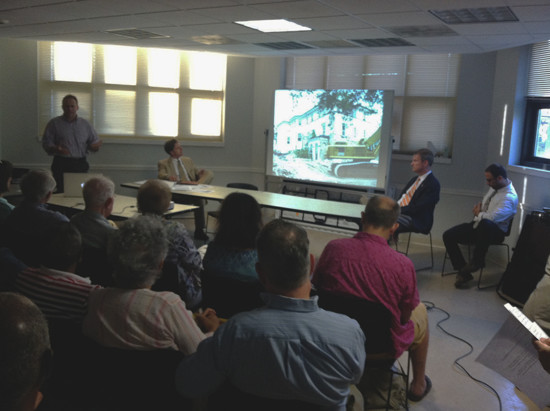A panel of city preservation experts offered a standing-room-only crowd some strategies last night on helping to preserve historic neighborhood buildings as waves of development continue to roll across the city.
Several groups have been fighting to save historically important buildings from demolition proposed by developers looking to build housing for the young professionals and students who are largely responsible for the recent upswing in the city’s population.
“We need to stop the demolition derby,” Paul Steinke, head of the Preservation Alliance for Greater Philadelphia, told an audience at the Walnut West Public Library (40th and Walnut).
The goal of Wednesday’s meeting was to provide local residents and community organizations some ways to save historic buildings, including private residences, from future demolition. Steinke and others on the panel hope the fight currently brewing over Jewelers’ Row along the 700 block of Sansom Street might garner enough attention that city officials, including politicians, might become more preservation friendly.
Development behemoth Toll Brothers has proposed a 16-story luxury apartment building along the 700 block of Sansom that would require the demolition of five buildings that are part of Jewelers’ Row, the country’s oldest diamond district. Toll Brothers can do it “by right,” two words that have become the bane of preservationists and many neighbors around the city. The developer doesn’t need permission, as the current zoning on that block allows what they are planning and the buildings aren’t protected.
“This is a flashpoint,” said Patrick Grossi, the advocacy director at the Preservation Alliance. “We need to convince the city that they have to take historic preservation seriously.”
The situation is not unlike many in West Philly, including the recent row over 4046-48 Chestnut Street, that are expected to increase as development and demolition continues to change the complexion of neighborhoods.
“It’s really a losing game of catch-up,” said. “We’re constantly scanning the landscape looking for properties.”
All of this is more complicated than it seems, though, said Professor Aaron Wunsch of Penn, who has fought many preservation battles, including the recent one on Chestnut Street. Historic preservation is not the same as zoning, which governs future development. Historic preservation shouldn’t be used just to thwart development in general, he said.
“I’m hesitant about historical preservation used as a NIMBY tool to avoid density,” Wunsch said.
So what can residents and community organizations do?
The panel offered a couple of recommendations:
• Neighborhood Conservation District. This is a zoning “overlay” that provides for more stringent guidelines for builders. It does not, however, prevent demolition. Powelton Village has applied for one. Queen Village Neighbors Association was the first to get one – back in 2008. Here’s how they did it.
• Historic Designation. This is what the University City Historical Society was able to get for the buildings on Chestnut Street. Property owners can apply to have their homes or buildings near them considered for historic designation, which makes it much more difficult to demolish. The application is long. Here is a guide from the Preservation Alliance on how it works. The downside of historic designation for your home is that it seriously limits what you can do to your home, even dictating, as someone mentioned at last night’s meeting, what kinds of windows you can put in it.
• Historic District. This is the brass ring of preservation, allowing the Historical Commission to review every building permit. Every “resource” in the district is deemed “significant.” Obviously this is hard to get. There is only one in West Philly – Parkside.
In the meantime, perhaps the most important thing people can do is get behind legislation in the works that would delay demolition for historic evaluation, which would help alleviate what has become a race between developers and preservationists to get their applications in first.
– Mike Lyons






August 25th, 2016 at 9:58 pm
There is a better way to do it that no one is discussing:
I believe that it is the Philadelphia 10-year special tax abatement that has stimulated all the real estate demolition and building because that special abatement is only available to new construction.
Stop the 10-year tax abatement for new buildings and no one will want to invest in new construction in Philadelphia and we can hang on to our beloved deteriorating stock.
Consider another possible option: Extend the ten year tax abatement to investing in existing buildings. Reward upkleep and maintenance of historically authentic buildings.
Instead we are using the hammer of “Historic certification” of old buildings to render them worthless to developers and diminish the value to current owners who are unfortunate enouogh to possess them as they become handicapped by the unwanted designation.
The “Historic Certification” process is worse than government taking by eminent domain. Tthe owners of properies taken by eminent damain are at least compensated for their loss. Not so owners of properties hobbled by Historic Certification.
August 26th, 2016 at 9:11 am
the 10 year tax abatement is available for rehab work, with conditions, but it does not include upkeep and maintenance. But normally upkeep and maintenance, such as painting, would not cause your real estate taxes to increase.
August 26th, 2016 at 11:48 pm
Not sure about the semantic fine points but what would it take to get an injunction/retraining order or whatever on all pending demolition, and a requirement that it be undertaken only following a case-by-case review?